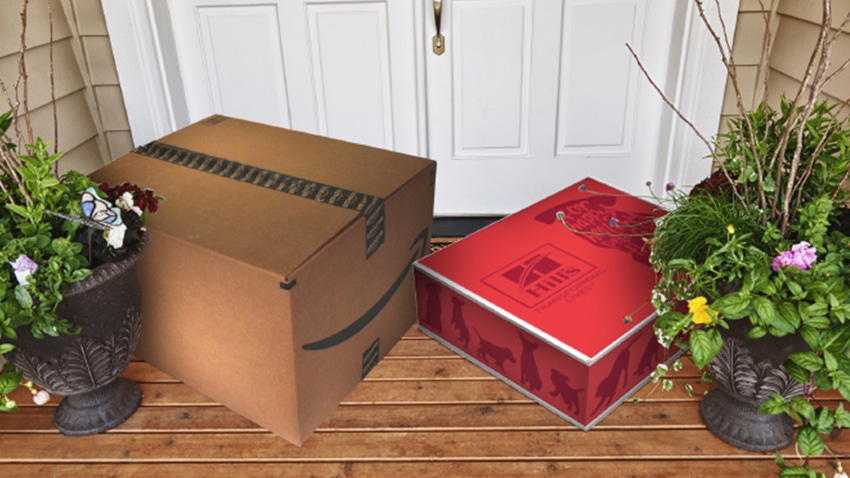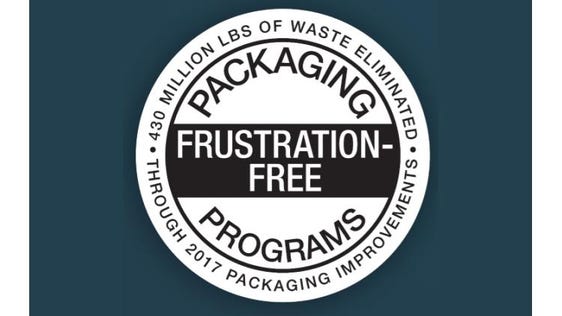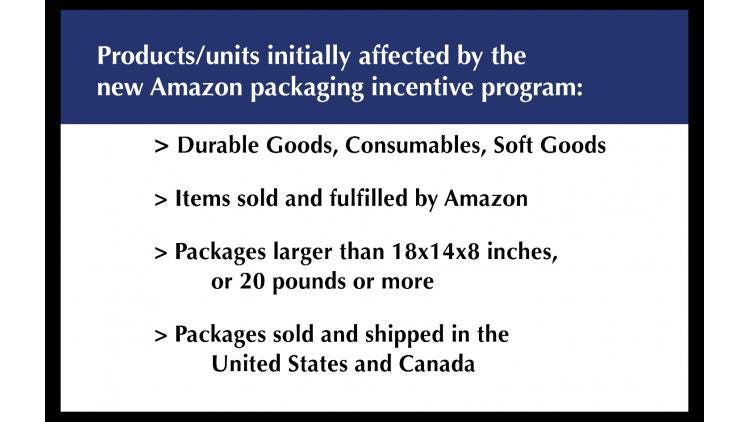Amazon incentivizes brands to create Frustration-Free Packaging

Yesterday, Amazon sent letters to thousands of brand-owner vendors affected by a new packaging program. So if you were wondering whether to design or redesign your packaging for the ecommerce channel, this might help you decide.
To help reduce packaging waste and improve efficiency of ecommerce shipping for its vendors, Amazon will require that select products being sold and fulfilled by Amazon arrive in its fulfillment centers in certified packaging under its Frustration-Free Packaging (FFP) program. This means that the packaging does not require any shipping preparation or an overbox to be applied. The vendor will retain its own branding on the shipment.
The deadline to certify is Aug. 1, 2019. The program offers an incentive to vendors, a generous one-time early adopter credit “to assist in the transitions costs;” after that date, there is an ongoing chargeback for every package not certified.
For those of you who lived through the disruption of Walmart’s Packaging Scorecard in 2006, this might feel like déjà vu all over again. But the environment is different now, literally and figuratively. Brands are learning to leverage innovation in ecommerce packaging—four of the 10 Diamond Award finalists in Dow’s 30th Awards for Packaging Innovation were for ecommerce packages. Just as the Packaging Scorecard spurred needed advancement in sustainable packaging that the entire industry benefitted by, this Amazon program has the potential to do the same for fast-growing ecommerce distribution.
Kudos to Amazon for stepping up. This packaging program is the right thing to do at the right time by the right leader.
Ecommerce packaging has been under fire recently regarding its sustainability. Over the last two years, Amazon has been actively encouraging its global vendors to use certified packaging to help reduce packaging waste as part of its Frustration-Free Packaging program.
Amazon has already shared on its website multiple successful case studies of how major brands have voluntarily optimized their ecommerce packaging through the FFP program—Procter & Gamble, Unilever and Hasbro among them.
In a video on the Amazon website, Hasbro talks about its experience: “When Amazon first approached Hasbro about Frustration-Free Packaging,” says Jacquie Patterson, packaging engineering for Hasbro, “it wasn’t quite on our radar yet. …Switching to Frustration-Free Packaging, we can see a savings of up to 50% or more in material usage and in shipping volume,” Patterson says. Hasbro svp Jeff Jackson concludes, “You feel great about it (FFP) at the end. You open it up, you have less waste and it’s much easier to grab that stuff and put it in your recycling bin and go.”
The online retailer has also been working with the packaging supplier community to create optimized ecommerce packaging solutions for other brand owners. Packaging Digest featured one of these innovations earlier this year in “How Amazon developed a leak-free trigger sprayer.”
In the 10 years since Jeff Bezos started FFP in 2007, Amazon has eliminated more than 500 million boxes and more than 244,000 tons of packaging materials through 2017. In 2017 alone, Amazon reduced its packaging waste by 16%, the equivalent of 305 million shipping boxes. But the message to industry has been “…we’re just getting started.”

To accelerate sustainability and efficiencies in the ecommerce supply chain, Amazon’s latest move to incentivize vendors to move to Frustration-Free Packaging supports its publicly stated goals of innovating product and packaging for ecommerce in ways that will:
1. Differentiate and optimize the customer’s experience;
2. Minimize the environmental impact of packaging; and
3. Create packaging at the lowest delivered cost.
Now, let’s dive into the details of Amazon’s ecommerce packaging requirements.
Limited scope
Not all products sold through Amazon will be included in the initial launch. The company will start with Durable Goods, Consumables and Soft Goods, segments that represent a large portion of its retail business. Durable Goods include toys, consumer electronics, home items and the like. Consumables are products such as diapers and cleaning products. Shoes and luggage are examples of Soft Goods.
To maximize how much packaging can be reduced, Amazon is starting with larger items that tend to create a lot of packaging waste—that is, packages larger than 18x14x8 inches, or 20 pounds or more.
The scope of this program is limited to products that are “Sold and Fulfilled by Amazon.” Products that are sold by and fulfilled by a third party, or sold by a third party and fulfilled by Amazon, are not included in the program for now.
By the Aug. 1, 2019, certification deadline, vendors will need to enroll their products/packages into Amazon’s Frustration-Free Packaging certification program (Tier 1-FFP or Tier 2-SIOC) and submit results of the ISTA 6-Amazon.com Ships in Own Container (SIOC) test method.

Help is here
If your products are included in Amazon’s new packaging initiative, what should you do now? Amazon has prepared for this in a few ways:
• Amazon’s Frequently Asked Questions-Vendor Packaging Incentive document goes into detail on the program specifics, including exemptions, the early-adopter credit and chargeback fees.
• Amazon’s recently revamped website www.aboutamazon.com/sustainability/packaging has information and resources in four areas: Design, Testing, Certification and Case Studies. This will be your primary resource, with enrollment documents, testing instructional videos and examples for inspiration.
• In the last couple years, Amazon has certified more than 20 third-party testing labs. Called APASS, the Amazon Packaging Support and Supplier network is a suite of certified partners ready to help Amazon scale up for this program. Find the APASS network list here.
Companies can have their packages tested by any ISTA certified lab. Or, if companies have their own packaging test labs, they can be trained in the Amazon test methods and do their own tests.
Still more questions
Industry is sure to have more questions, such as…
How much packaging waste does Amazon expect to reduce/eliminate with this program?
How much will certification cost vendors?
How will Amazon monitor incoming items to ensure they have the proper certification?
How much time will this packaging program save at Amazon fulfillment centers by reducing/eliminating over-boxing?
What estimated costs will be eliminated, again by reducing/eliminating over-boxing by Amazon?
Amazon’s program is starting with Durable Goods, Consumables and Soft Goods larger than 18x14x8 inches or 20 lbs or more that are sold and fulfilled by Amazon. Does that mean the program will expand to other products in the future?
In coming days and weeks, Packaging Digest will monitor and report on more details of Amazon’s packaging initiative as we learn them, as well as on industry reaction.
Are you among those affected? What do you think of Amazon’s Frustration-Free Packaging incentive program? Comment below, please.
******************************************************************************
Did you know? Our parent company owns these popular packaging events: WestPack, EastPack, MinnPack, PackEx Toronto and PackEx Montreal. Click the links to learn how you can connect in person with leading packaging technology partners, expand your professional network, hear experts analyze key packaging trends and gain a better understanding of today's critical issues.
About the Author(s)
You May Also Like




